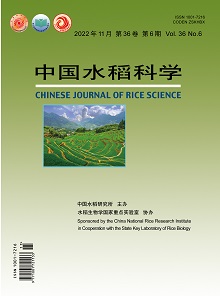【Objective】 The establishment of synthetic apomixis provides a way to fix heterosis in hybrid rice. However, synthetic apomixis only produces few clonal seeds with many tetraploid seeds. Thus, it is necessary to develop a simple and efficient method to select cloned seeds through the synthetic apomixis.【Method】 The seedlings of Chunyou 84 and MiMe (the PAIR1, REC8 and OSD1 were simultaneously mutated, which can turn meiosis into mitosis in rice) were exposed to different temperature and salt concentrations, and their morphological differences were identified to determine the best treatment conditions. Then, seedlings germinated from Fix plants(The PAIR1, REC8, OSD1 and MTL were simultaneously mutated in hybrid rice Chunyou 84 by genome editing technology) were treated in the optimal treatment conditions, and cloned seeds were sorted according to morphological differences. Finally, flow cytometry was used to determine the efficiency of the distinguishing cloned seeds method.【Results】 Fix plants produce 4.4% clonal seeds and 95.6% tetraploid plants, while the descendants of MiMe are all tetraploid materials. The seeds of Chunyou 84 and MiMe were germinated on a net floating on deionized water at 23 ℃, 28 ℃and 32 ℃for 48 h, and the primary root diameter of MiMe was found significantly larger than that of Chunyou 84 under all the three treatments at the most favorable temperature of 28 ℃. Then, the seedlings of Chunyou 84 and MiMe were cultured with 0%, 0.05%, 0.1%, 0.2% and 0.5% NaCl solutions for 7 days. Though the root and shoot length did not show significant difference between Chunyou 84 and MiMe plants, the first complete leaf from Chunyou 84 exhibited severe atrophic and necrosis phenotype in 0.1% NaCl solution, while the MiMe plants were slightly affected by salt damage. According to the above results, firstly, we germinated the Fix seeds on a net floating on deionized water at 28 ℃for 48 h, and screened the putative cloned Fix plants by observing the primary root. Then, the putative cloned Fix plants were cultured with 0.1% salt solution for 7 days, and the putative tetraploid plants were discarded based on the salt damage of the first complete leaf. Finally, the selected individual plants were verified by flow cytometry with screening efficiency of 61.1%. The cloned plants were grown in field and showed significant difference with tetraploid plants at maturity stage.【Conclusion】 After temperature and salt treatment of apomixis material Fix seeds at seedling stage, the clonal Fix plants can be roughly screened by morphological differences of root and leaf phenotype.

